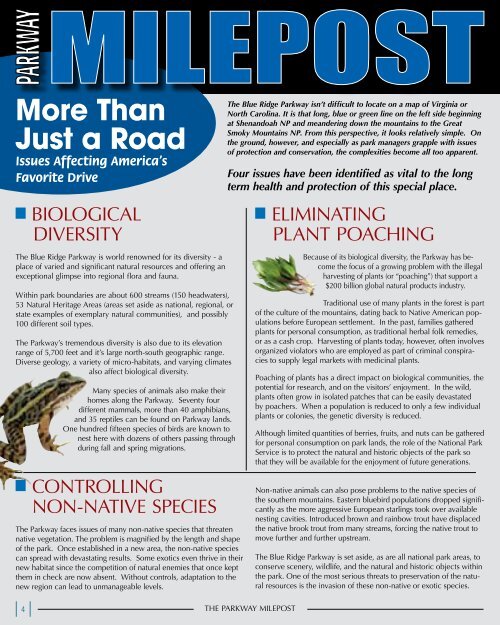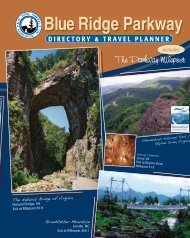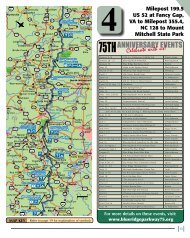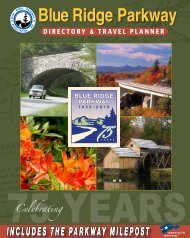Blue Ridge Park way - Massanutten Resort
Blue Ridge Park way - Massanutten Resort
Blue Ridge Park way - Massanutten Resort
Create successful ePaper yourself
Turn your PDF publications into a flip-book with our unique Google optimized e-Paper software.
More Than<br />
Just a Road<br />
Issues Affecting America’s<br />
Favorite Drive<br />
BIOLOGICAL<br />
DIVERSITY<br />
The <strong>Blue</strong> <strong>Ridge</strong> <strong>Park</strong><strong>way</strong> is world renowned for its diversity - a<br />
place of varied and significant natural resources and offering an<br />
exceptional glimpse into regional flora and fauna.<br />
Within park boundaries are about 600 streams (150 headwaters),<br />
53 Natural Heritage Areas (areas set aside as national, regional, or<br />
state examples of exemplary natural communities), and possibly<br />
100 different soil types.<br />
The <strong>Park</strong><strong>way</strong>’s tremendous diversity is also due to its elevation<br />
range of 5,700 feet and it’s large north-south geographic range.<br />
Diverse geology, a variety of micro-habitats, and varying climates<br />
also affect biological diversity.<br />
Many species of animals also make their<br />
homes along the <strong>Park</strong><strong>way</strong>. Seventy four<br />
different mammals, more than 40 amphibians,<br />
and 35 reptiles can be found on <strong>Park</strong><strong>way</strong> lands.<br />
One hundred fifteen species of birds are known to<br />
nest here with dozens of others passing through<br />
during fall and spring migrations.<br />
CONTROLLING<br />
NON-NATIVE SPECIES<br />
The <strong>Park</strong><strong>way</strong> faces issues of many non-native species that threaten<br />
native vegetation. The problem is magnified by the length and shape<br />
of the park. Once established in a new area, the non-native species<br />
can spread with devastating results. Some exotics even thrive in their<br />
new habitat since the competition of natural enemies that once kept<br />
them in check are now absent. Without controls, adaptation to the<br />
new region can lead to unmanageable levels.<br />
4<br />
The <strong>Blue</strong> <strong>Ridge</strong> <strong>Park</strong><strong>way</strong> isn’t difficult to locate on a map of Virginia or<br />
North Carolina. It is that long, blue or green line on the left side beginning<br />
at Shenandoah NP and meandering down the mountains to the Great<br />
Smoky Mountains NP. From this perspective, it looks relatively simple. On<br />
the ground, however, and especially as park managers grapple with issues<br />
of protection and conservation, the complexities become all too apparent.<br />
Four issues have been identified as vital to the long<br />
term health and protection of this special place.<br />
THE PARKWAY MILEPOST<br />
ELIMINATING<br />
PLANT POACHING<br />
Because of its biological diversity, the <strong>Park</strong><strong>way</strong> has become<br />
the focus of a growing problem with the illegal<br />
harvesting of plants (or “poaching”) that support a<br />
$200 billion global natural products industry.<br />
Traditional use of many plants in the forest is part<br />
of the culture of the mountains, dating back to Native American populations<br />
before European settlement. In the past, families gathered<br />
plants for personal consumption, as traditional herbal folk remedies,<br />
or as a cash crop. Harvesting of plants today, however, often involves<br />
organized violators who are employed as part of criminal conspiracies<br />
to supply legal markets with medicinal plants.<br />
Poaching of plants has a direct impact on biological communities, the<br />
potential for research, and on the visitors’ enjoyment. In the wild,<br />
plants often grow in isolated patches that can be easily devastated<br />
by poachers. When a population is reduced to only a few individual<br />
plants or colonies, the genetic diversity is reduced.<br />
Although limited quantities of berries, fruits, and nuts can be gathered<br />
for personal consumption on park lands, the role of the National <strong>Park</strong><br />
Service is to protect the natural and historic objects of the park so<br />
that they will be available for the enjoyment of future generations.<br />
Non-native animals can also pose problems to the native species of<br />
the southern mountains. Eastern bluebird populations dropped significantly<br />
as the more aggressive European starlings took over available<br />
nesting cavities. Introduced brown and rainbow trout have displaced<br />
the native brook trout from many streams, forcing the native trout to<br />
move further and further upstream.<br />
The <strong>Blue</strong> <strong>Ridge</strong> <strong>Park</strong><strong>way</strong> is set aside, as are all national park areas, to<br />
conserve scenery, wildlife, and the natural and historic objects within<br />
the park. One of the most serious threats to preservation of the natural<br />
resources is the invasion of these non-native or exotic species.








